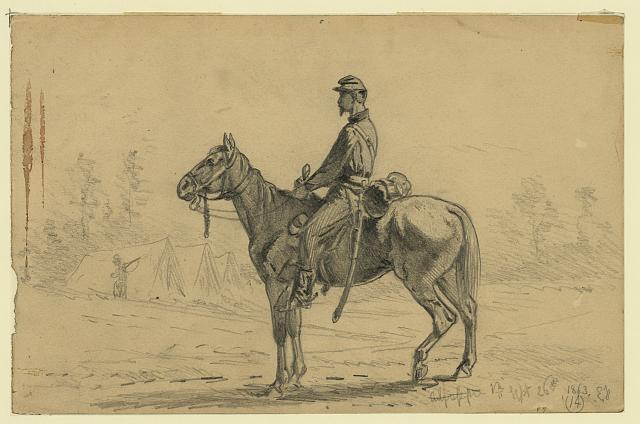O! for a horse with wings! ~William Shakespeare, Cymbeline
I had long ago dismissed the idea that I had any relatives who fought in the Civil War. After all, my paternal grandfather was a first-generation American, born nearly 15 years after the war, in 1881. And on my maternal side, my mother arrived from England in 1946, after the end of World War II—no Civil War vets in her family!

Cavalry orderly awaiting orders. Image from the Library of Congress Prints & Photographs Online.
The first inkling that there were indeed a few Civil War veterans amongst my ancestors appeared in a short biography of my father’s great-grandfather, Henry S. Roberts. His granddaughter Ruth married my grandfather, and the Roberts family had been in upstate New York at least as far back as the early 1800s. The biography included a statement about Henry’s wife, Hannah Beaumont Roberts: “Mrs. Roberts had two brothers in the Tenth Cavalry.” Aha!
With the help of such Ancestry.com databases as New York Civil War Muster Abstracts, U.S. Civil War Soldier Records and Profiles, the Civil War Pension Index, and the 1890 Veterans Schedules, I was able to find information about a great-great uncle who served with the 10th New York Cavalry. I knew he had been injured, and that he had served in Company L. But to find out more, I got copies of his pension files from The U.S. National Archives and Records Administration (NARA).
George Patinson Beaumont was born to Ingham Beaumont and Mary Oldfield in Penn Yan, Yates County, New York on June 14, 1838. In the 1860 U.S. census, he was single and living in a boarding house in Penn Yann, working as a blacksmith. The war was just a little more than 1 year away. The 10th New York Cavalry regiment was formed in December 1861, and about a year later, added a third battalion. That’s when George joined. On October 29, 1862, at the age of 24, he mustered in to Company L of the New York 10th Cavalry Regiment, in Elmira, New York.
According to Ken Morris’ Brief History of the 10th Cavalry, New York was the first state to supply volunteer cavalry regiments to the Union Army, in 1861. Although many of the recruits reportedly had little experience with horses, I expect that my uncle George was probably at an advantage due to his occupation as blacksmith!
Among the papers in George’s files were doctors’ statements and descriptions of his current state of health, as well as what happened to him when he was serving with the 10th NY Cavalry. So what did happen, and where?
According to the files, George was injured during the famous Battle of Fredericksburg, Virginia, which took place between December 11 and 15, 1862, and was the largest battle of the war. The battle resulted in a Confederate victory, with about 12,700 Union soldiers killed—about twice the number of Confederates.
Major General William B. Franklin was in charge of a division, and my great-great uncle George was on duty as his orderly. Fred A. Gee, the 1st Lieutenant of “L” Company with the 10th, described what he knew of the event that caused George’s injuries.
Major General William B. Franklin. ~image courtesy of Wikipedia.
The claimant was detailed and acted as Orderly to Genl Franklin… at battle of Fredericksburg Va., December 13th 1862… he claims to have incurred an injury to his back and loins from his horse falling on him.
Another description says that the horse upon which George was mounted fell upon him while attempting to jump over a stream. Ah, if only the horse could fly.
George’s pension declaration relates that he was “so badly injured about the back and loins as to be disabled for duty and was sent to his regimental hospital for several days, and after examination by the surgeons, was sent by train to a hospital in Washington, DC… and was sent to Davids Island Hospital[New York] where he remained about a year, and then returned to his regiment doing light duty till his discharge.”
This injury plagued my uncle for the rest of his life. His pension documents show that he had trouble with his heart and back, and in the 1890 Veterans Schedules, his disability was described as “chronic diarrhea”! The pension records show that he eventually employed a man to work for him, as he was unable to do his own work.
George died in 1897 of heart disease at the age of 54, and his widow, Adalade Hardin Beaumont, applied for a widow’s pension. I sometimes think that George was fortunate that he was serving as an orderly during the Battle of Fredericksburg. Perhaps it kept him out of the line of fire, when so many of his fellow soldiers were not so lucky. Even though he must have suffered the rest of his life after being “done in” by his horse, at least he was able to go home to his wife and two children. Too bad his horse didn’t have wings.


Pingback: 52 Ancestors Challenge: Week 13 Recap | No Story Too Small